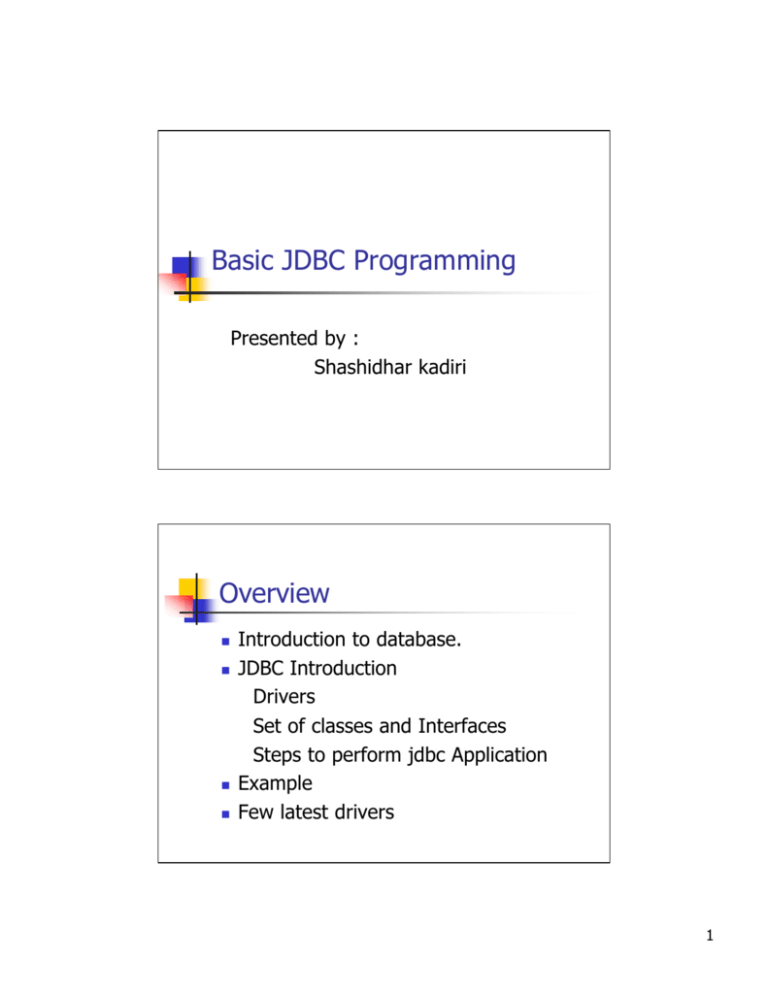Basic JDBC Programming Overview
advertisement

Basic JDBC Programming
Presented by :
Shashidhar kadiri
Overview
n
n
n
n
Introduction to database.
JDBC Introduction
Drivers
Set of classes and Interfaces
Steps to perform jdbc Application
Example
Few latest drivers
1
Introduction to Database
n
Why do we need Database?
Database came to existence to replace files
which were used to store data.
The disadvantages of using files are like :
Redundancy
Inconsistency
Security
Loss of integrity
Poor performance
Database Management
System
n
n
n
n
Query Processor : Checks for syntactical and
semantics of query.
Database Manager : Checks for the existence
of required table.
File Manager : Directly contacts d/b and
retrieves data. It has all the read and write
permissions on the d/b.
Front end like VB with backend Oracle
requires a mediator like ODBC (Open Data
Base Connectivity).
2
Jdbc Introduction
n
n
n
n
JDBC is basically used because it can
access any database.
Jdbc uses drivers to connect to the
database, which are categorized into
four types.
Jdbc has a set of exclusive interfaces
and classes.
Few steps to perform Jdbc application.
Jdbc driver (1)
n
Jdbc-Odbc bridge driver :
This bridge driver can be used to
connect to any existing database, I.e,
ODBC compliant.
3
JDBC Driver (2)
n
Native-API/partly Java driver :
Converts JDBC calls into database
specific calls for database such as
SQl , Oracle etc. Driver is partly
written in “Java” and partly in “C” .
JDBC Driver (3)
n
Net-protocol/all-Java driver :
This driver is used in Internet to
connect to the database at
different locations. This is
supposed to be the most flexible
driver.
4
JDBC Driver (4)
n
Native-protocol/all-Java driver :
Converts the JDBC calls into the
network protocol used by DBMS’s
directly. This is very much used in
intranet access.
JDBC Architecture.
Application
Jdbc Driver Manager
Jdbc-odbc bridge driver
Native-API/partly Java driver
Net-protocol/all-Java driver
Native-protocol/all -Java driver
Odbc
Data Base
5
Getting ready for programming
Used in Jdbc
Interfaces :
Connection
Statement
Result set
Prepared statement
Result set Meta data
Callable statement
D/B Meta data
n
Classes :
Driver manager
Date Time
Types
Date
Driver property
information
Time stamp
n
6
Interfaces
n
n
n
Connection :
This Interface is used to establish the
connection with the database.
Statement :
Acts as a handle to take user defined query
to the d/b.
Result set :
Returns the result of the Query from the
database.
Interfaces
n
n
n
n
Contd..
Prepared statement :
Takes values at runtime from the user and
pass the query to the database.
Result set Meta data :
Informs about the result set.
Callable Statement : This statement is used
to call the stored procedure.
Data Base Meta Data :
Informs about the data itself.
7
Classes
n
n
n
Driver manager :
Has the list of all drivers present in the
system.
Types :
Has the constant integer value which are of
Sql type.
Time stamp :
This gives the latest modified or access time.
Steps to write Jdbc Application
n
n
n
n
n
n
Load the driver into memory.
Establish the connection with the d/b.
Execute the query.
Obtain the result set.
Interpret the result set.
Close the connection.
8
Load the driver :
Class forname
(“Sun.jdbc.odbc.JdbcOdbcDriver”);
This statement is used to load and
register the driver in to the memory.
Establish the connection :
Connection
con=DriverManager.getConnection
(“Jdbc:Odbc:DSN”);
This statement is used to establish the
connection with the database.
Whenever getConnection is called in
turn it calls 4 methods of the driver
interface.
9
Methods of driver :
n
n
n
n
GetDriver() : It gets the first
encountered driver which is present in
jdbc-odbc driver class.
Accepts URL() : Checks if the DSN
entered is same as the driver loaded.
Register driver() : Checks if the D/B is
eligible to the DSN.
Connect() : Returns connection object.
Statement :
n
Statement st = con.CreateStatement();
This allows to assigning the “statement”
to a variable “st” which is returned from
“CreateStatement” .
10
Resultset :
n
Resultset rs =
st.executeQuery(“select * from emp”);
This statement gets the result set in
return from the query executed. “rs”
has the result set values.
Interpret the result set :
n
int empno=rs.getInt(1);
As we know “rs” is the result set
variable it has an extension of “getInt”
which gets the value in that particular
column (1). The data type should be
correct and known so that the returned
value is easily collected.
11
Close the Connection :
Resultset.close();
This statement closes the connection
with the database.
Example
Import java.sql.*;
Public class first
{ Public static void main () {
try
{ Class forName (“sun.jdbc.odbc.JdbcOdbcDriver”);
Connection con=DriverManager.getConnection(“jdbc:odbc:DSN”,” User”,”password”);
Statement st=con.createstatement ();
Resultset rs=st.executeQuery( “Select * from table”);
While(rs.next())
{
int ac=rs.getInt(1);
String name=rs.getString(2);
String addrs= rs.getString(3);
Float bal= rs.getFloat(4);
}// while
System.out.println(“Account #”+ac);
System.out.println(“Name ”+name);
System.out.println(“Address”+addrs);
System.out.println(“Balance”+bal);
}// try
catch(Exception e){}
rs.close();
}// main
}// class
12
Few latest jdbc drivers
Cloudscape
Jturbo
inet Merlia
inet Gate
inet opta
Sources :
n
n
n
www.Java.sun.com
www.inetsoftware.de
www.cloudscape.com
13
